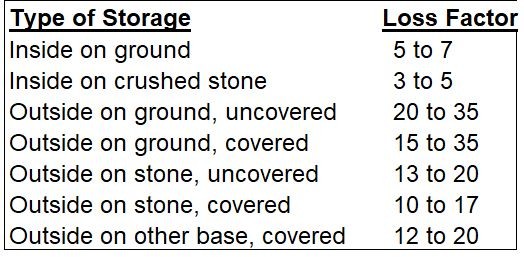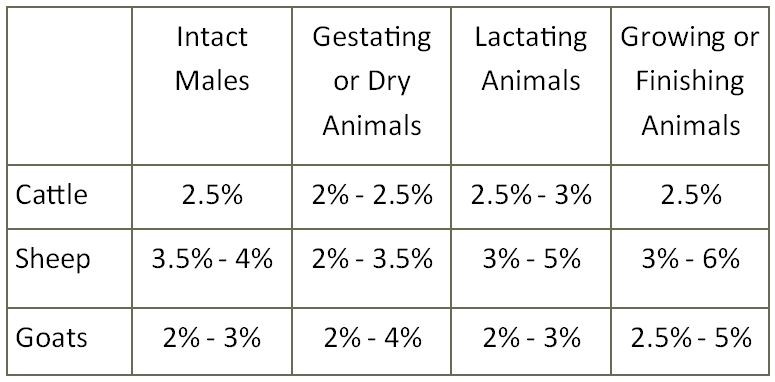Determining Forage Inventories with Pen and Paper
Amy Barkley, Livestock Specialist
Southwest New York Dairy, Livestock and Field Crops Program
This year, like last year, has been a bit of a rocky one for livestock farmers across SWNY concerning their forage harvests. While the weather was ideal for many to get an early first cutting off, we began to experience droughty conditions that persisted until just a few weeks ago. Many second cuttings were poor, if they were taken off at all. Only some farms in our region experienced the Goldilocks weather that resulted in good hay harvests. Regardless of what was experienced, it's time to calculate the amount of dry hay and fermented bales available as we go into winter. Getting hay this time of year to fill in any production loss will be much easier than trying to source it when it's February and you realize that you're going to run short.
To calculate forage inventories is simple, but you'll need the following information:
· Number of bales
· Average weight of bales
· Dry Matter of bales (baleage is between 50% - 60% dry matter, hay should be around 10% - 15% dry matter)
· Anticipated storage loss (see table 1) and feeding loss
· Number of animals on the farm
· Anticipated consumption of animals (see table 2)
· The number of days you anticipate having to feed this winter
To calculate the amount of forage you have available:
- You'll first need to multiply the average weight of your bales by the number of bales you have. For this example, let's say that we have 500 small squares of dry hay that weigh 40 pounds each. That would be 20,000 pounds of hay on an as-fed basis.
- After the total weight of forage available is calculated, calculate the percentage of that forage that is dry matter. For example, if we know that the moisture of our dry hay is 12%, that means that the dry matter value will be calculated by taking the difference of 100% dry matter and 12% dry matter, which is 88%. Then, we will take that percentage as a decimal (.88 in this example), and multiply it by the weight of forage we have on an as-fed basis. For our example, that would be .88 x 20,000 = 17,600 pounds of dry matter available.
- The anticipated loss is determined from the sum of the loss expected during storage plus the anticipated feeding loss. The table below will help you estimate loss associated with storage. Feeding loss is based on experience. While storage loss estimates are pretty standard, feeding loss comes from factors including the feeder, feeding area, and species. This number is unique to your farm. For our example, let's say that our hay is stored in the attic of a barn (0% loss) and our animals tend to waste 10%. Our loss factor is 0% + 10% = 10%, which means that our animals consume 90% of the forage we put up. The loss factor is then multiplied by the amount of dry matter available to get an estimate of what dry matter our animals have available to consume this winter. In our example, that's .9 x 17,600 = 15,840 pounds of feed available.
 Table 1. This loss table is based on unwrapped haybales. Wrapped bales will have little to no loss. This table was created by Bill Halfman, University of Wisconsin. Click to enlarge.
Table 1. This loss table is based on unwrapped haybales. Wrapped bales will have little to no loss. This table was created by Bill Halfman, University of Wisconsin. Click to enlarge.The next step in the calculation process is to determine how much feed your animals will consume over the course of a day:
- First, list the number of animals you have and their production groups. For my example, I have 20 ewes that weigh 120 pounds each and 1 ram and 1 wether that weigh 150 pounds each. The example doesn't use lambs because in this hypothetical, they were lambed in the late winter, put out to pasture at weaning, and sold before winter. Idealistic, I know (:
- Next, determine the consumption of your livestock. The table below, complied from NRC (National Research Council) recommendations, gives general estimates of the consumption of the major grazing species classes as the % of bodyweight per day. Our example ewes are gestating, and because they have a tendency to carry twins and triplets, and because they will be nursing while on stored feed, their feed needs will fall on the higher end of gestating and lactating range for sheep. Let's go with 4% here.
- Multiply the number of animals in each group by their weight and then by their anticipated consumption as a percent of bodyweight. Then, add those consumption values of the groups together. Our example flock has a ewe group where 20 animals x 120 pounds bodyweight x .04 = 96 pounds of feed for the ewes/day. The wether and ram are 300 total pounds x 0.035 = 10.5 pounds of feed for the males. That means that all the sheep on the farm are anticipated to consume 106.5 pounds of dry matter feed per day.
 Table 2. Nutrient values for the three major grazing species by production category. The values are derived from NRC recommendations. Generally, animals in the later part of gestation will require more nutrients or a higher volume of feed to meet their energy and protein needs. The same goes for animals that are expected to gain at a high rate vs a moderate or slow rate. Lactating animals with multiples require more feed than lactating animals with singles. Click to enlarge.
Table 2. Nutrient values for the three major grazing species by production category. The values are derived from NRC recommendations. Generally, animals in the later part of gestation will require more nutrients or a higher volume of feed to meet their energy and protein needs. The same goes for animals that are expected to gain at a high rate vs a moderate or slow rate. Lactating animals with multiples require more feed than lactating animals with singles. Click to enlarge.
Finally, calculate how much feed they will consume this winter and compare that number to the amount of forage you have available.
- I generally recommend that producers estimate for a late start on the pastures and an early pull in the fall since we know that mother nature can be fickle. At this point, you can even estimate in a set number of days for summer feeding if you find that your pastures normally enter a summer slump and/or calculate a set number of extra days in the case of drought. In our example, we're going to pretend that we have a nice mix of cool season pastures, silvopasture, and summer annuals, so we won't need to calculate for summer feed. The grazing season on our imaginary hilltop starts around May 20th, and ends around November 1st, since we stockpile. That gives us 200 days for the grazing season, or 165 days for the winter feeding season.
- Multiply the number of days on feed by the pounds you anticipate the animals to consume per day. Our little flock will consume 106.5 pounds of dry matter/day x 165 days = 17,572 pounds of dry matter this winter.
- Compare the results of your calculation to your stored feed, and see how close you are! In our example, we have 15,840 pounds of dry matter available, and need 17,572 pounds of dry matter. That's really close, but if I had to choose in this example, I would pick up one more ton of forage just to be on the safe side. Sometimes, the amount of forage you need will be more than what you have, meaning you need to buy in forage. Other times, there is a huge excess of stored feed calculated, which means you can keep some for insurance or sell some. This decision comes from experience and your comfort with risk.
As you're going through this series of calculations, and you're unsure where you fall in terms of moisture, loss, or animal weights, estimate more moisture, loss, and weight than less. This will make your calculation more conservative. It's better to have hay left over at the end of the year than it is to need to scramble at the last minute to secure feed. With the days getting crisp and cool, I highly recommend running these numbers as soon as you can if you haven't already.
If you need any assistance or have any questions, feel free to reach out at amb544@cornell.edu or 716-640-0844.
Upcoming Events
WEBINAR - Automated Milking Systems Efficiency: Balancing Focus on Individual Cows and System Optimization
May 8, 2024
Please join Cornell the SWNY team and MSU Extension for our talk with Dr. Pablo Silva Boloña on improving efficiency of Automated milking systems by focusing on milking settings for individual and group success.
Broiler Field Day at Sunny Cove Farm
June 6, 2024
Alfred Station, NY
Join us for a field day to explore broiler production, processing, and finances. Meghan Snyder of Sunny Cove Farm will be our host. She raises small batches of organic broilers, processing them on-farm under the 1,000 bird exemption.
Stockmanship and Stewardship 2024
October 25, 2024
Hamburg, NY
Save the date!! The event is one of 4 across the US and is a two-day educational experience featuring low-stress cattle handling demonstrations, Beef Quality Assurance educational sessions, facility design sessions, and industry updates.
Announcements
No announcements at this time.





